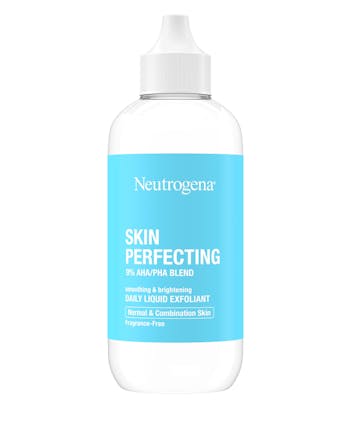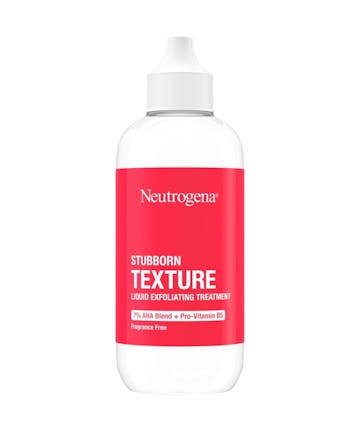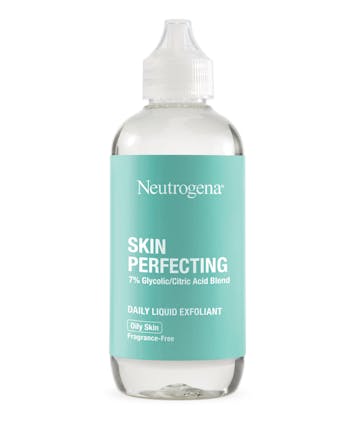Who wants dull, rough or lackluster skin? No one! The good news: There are ways to address these issues. Time to learn more about chemical vs. physical exfoliants and how to use them.
Skin exfoliation is a simple technique that dates back to ancient Egypt and involves sloughing away dirt and dead skin cells to reveal fresh, radiant skin. And it's still the key to a vibrant, healthy-looking complexion.
It's important to consider how chemical vs. physical exfoliants can benefit your skin. If your skincare routine is looking a little rough around the edges, here's how to smooth it out with exfoliation.
What Is a Chemical Exfoliant?
Chemical exfoliants work by breaking down the intercellular "glue" that holds dead skin cells together. Once these bonds dissolve, the dead cells fall away allowing newer skin to surface. Neutrogena's Stubborn Texture Liquid Exfoliating Treatment is a great choice for a gentle yet effective liquid exfoliator for glowing skin.
While they may sound daunting, chemical exfoliators can be surprisingly gentle, often containing low levels of natural, food-derived acids and enzymes. Some examples include alpha hydroxy acid exfoliants, like lactic acid (found in sour milk), glycolic acid (from sugar cane) and tartaric acid (from grapes). Skin that's oily or prone to enlarged pores or blemishes will do well with salicylic acid, an oil-soluble beta hydroxy acid that can penetrate pore-clogging debris. To boost cellular turnover, neoglucosamine is a chemical exfoliant that makes your skin feel hydrated while visibly reducing hyperpigmentation.
How Long Does Chemical Exfoliation Take to Work?
Depending on your skin type and regularity of use, you might notice some benefits of chemical exfoliation instantly, but it's not uncommon for it to take several weeks to see full effects. How often should you use a chemical exfoliant? For best results, follow product directions.
How to Use Chemical Exfoliant
If you opt to use a chemical exfoliator in your skincare routine, look for a product made with the natural exfoliants listed above. A good one to try is Neutrogena's Stubborn Texture Acne Facial Cleanser, which contains polyhydroxy acid (PHA), glycolic acid (AHA) and salicylic acid (BHA) to gently remove dead skin and excess oil and sweep away surface skin for a clearer looking complexion.
Do You Wash Off a Chemical Exfoliant?
As an added bonus, chemical exfoliants don't require any scrubbing on your part. Leaving it on the skin allows it to penetrate skin's deeper layers and boost cellular turnover without the friction that could upset sensitive skin.
What Is a Physical Exfoliant?
With physical exfoliators, you manually scrub away dead cells from the skin's topmost layer using abrasive ingredients like sugar, microbeads, rice bran powder or jojoba seeds. The scrubbing action boosts the feeling of microcirculation and lymphatic drainage, leaving you with a fresh, glowing appearance.
While the treatment offers a dose of instant gratification, it does come with a caveat: If your product's exfoliant contains jagged particles or you scrub too vigorously while exfoliating, a physical exfoliator might leave your skin with microtears rather than a glowing complexion. Avoid these issues by choosing products with smooth, round granules and treating your skin gently as you exfoliate.
What's the Difference Between Chemical and Physical Exfoliants?
Now you know about both chemical and physical exfoliants. But what is the difference between physical and chemical exfoliation? In chemical exfoliation, you're relying on acids to remove the top layers of skin. The great thing about chemical exfoliation is that there's no scrubbing required, while physical exfoliants manually remove dead skin through scrubbing or particles.
Wondering if you can use both types of exfoliants in your skincare routine? While you can alternate between the two, it's best not to use chemical and physical exfoliants at the same time or even on the same day. Over-exfoliation can irritate your delicate skin.
It's Possible to Over-Exfoliate
As with most things in life, moderation is key. After all, there are only so many dead cells to slough away. Going overboard and over-exfoliating can disrupt your skin's natural barrier, causing irritation, inflammation and breakouts. It could also make you more vulnerable to sun damage and moisture loss.
So, start slowly and gradually work your way up to exfoliating two or three times a week. The key is to watch how your skin reacts and go from there. Finally, remember that freshly exfoliated skin is more fragile and needs to be protected with a good moisturizer and sunscreen.













